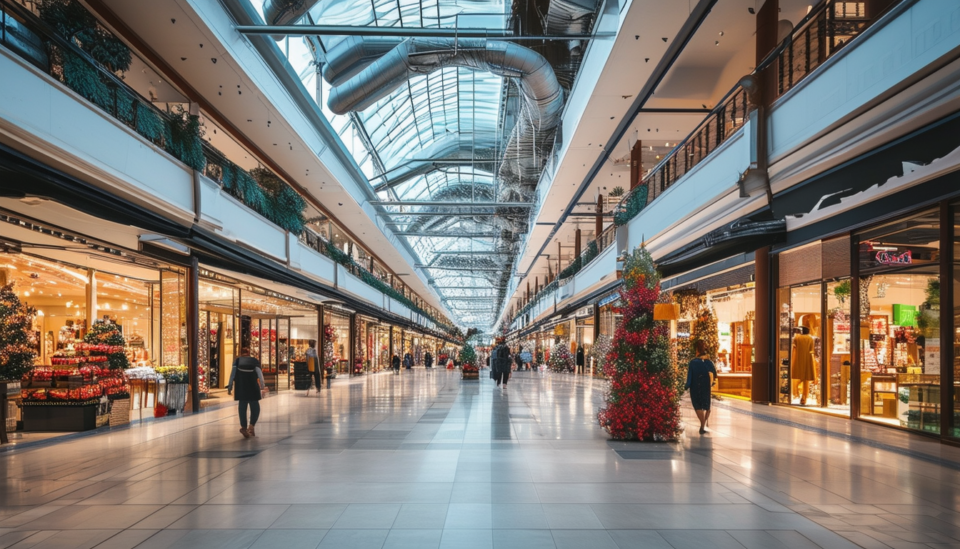Ensuring optimal ventilation in retail spaces is vital for maintaining a pleasant shopping experience, preserving product quality, and reducing energy costs. Retail environments face unique challenges because of varying layouts, products, and customer needs. Below, we delve into the most common ventilation challenges and practical solutions to address them effectively.
1. Temperature Control & Air Mixing
Maintaining consistent temperature and humidity in retail spaces is a constant challenge, especially in:
- High-ceiling areas where warm air tends to rise, creating uncomfortable temperature layering.
- Spaces with frequently opened doors or windows, allowing outdoor air to disrupt climate control.
Key Impacts:
- Perishable goods, medicines, and sensitive materials may spoil because of rapid temperature changes.
- Customers and staff experience discomfort, leading to reduced satisfaction and productivity.
Solutions:
- Rapid door systems and air barrier systems to minimise air exchange and maintain internal stability.
- Fans to help distribute air and stabilise temperature:
- Giant Fans for large spaces
- Axial Fans for airflow
- Exhaust Fans for targeted extraction.
- Air Curtains to create invisible barriers, preventing external air from entering climate-controlled areas.

By combining these systems, retail ventilation can achieve a stable, comfortable environment while protecting products and reducing energy consumption.
2. Managing Strong Odours
Retail spaces, particularly food courts and beauty product sections, often grapple with unpleasant odours. These odours, if not effectively managed, can drive customers away and tarnish the shopping experience.
Common Issues:
- Insufficient ventilation capacity to handle odour sources.
- Poor placement of exhaust points, leading to lingering smells.
- Lack of regular system maintenance, reducing effectiveness over time.
Solutions:
- Install high-efficiency exhaust fans, such as:
- Axial Fans
- Roof Fans
- Wall Exhaust Fans
- Use activated carbon filters to neutralise odour-causing particles.
- Ensure adequate fresh air intake to dilute unpleasant smells and maintain air quality.
- Regularly service ventilation systems to ensure optimal performance.

By targeting odour-prone areas with these solutions, retailers can create a fresher, more inviting shopping environment.
3. Boosting Energy Efficiency
Energy efficiency is vital for retail, as heating, cooling, and ventilation drive high operational costs. Inefficient systems lead to:
- Overworked HVAC systems and higher energy bills.
- Uneven temperature distribution, creating hotspots and customer discomfort.
Solutions:
- Adopt smart ventilation systems with:
- Variable-speed fans to adjust airflow as needed
- Occupancy sensors and automated controls for real-time adjustments.
- Integrate heat recovery systems to reclaim energy from exhaust air, reducing heating and cooling demands.
- Use energy-efficient ventilation options, such as:
- Ceiling Fans for improved air circulation
- Axial Fans to regulate air quality
- Air Curtains to limit heat loss and save on energy costs.
These solutions not only reduce energy consumption but also lower operational costs and carbon footprints, contributing to environmental responsibility goals.
4. Optimising Shopping Centre Air Quality
Large shopping centres face air quality challenges because of varied spaces like food courts, stores, and restrooms. Without proper shopping center ventilation, these spaces can suffer from:
- Pollutant and CO2 buildup, leading to an unhealthy environment.
- Varying air quality demands across different zones.
Solutions:
- Implement zoning strategies to meet the specific ventilation needs of each area. For example:
- Enhanced systems for food courts to manage cooking odours and heat.
- Balanced air circulation for retail stores to ensure customer comfort.
- Ensure adequate air exchange to control pollutants, odours, and carbon dioxide.
- Schedule regular system maintenance to meet health and safety standards.

Optimising air volumes and space for ventilation equipment ensures better air quality without compromising on aesthetics or functionality.
5. Ventilation for Sensitive Products
Products like medicines, electronics, and fine art require precise environmental conditions to remain in top condition. Poor ventilation can lead to:
- Hotspots and condensation, causing product damage.
- Pollution from airborne particles, affecting quality.
Solutions:
- Install filter fans to remove particulates and maintain clean indoor air quality.
- Use air curtains to prevent external contaminants and regulate humidity.
- Design customised ventilation systems with:
- Precise controls for stable temperature and humidity.
- Advanced filtration systems to protect sensitive materials.
These solutions ensure products remain in pristine condition, safeguarding their value and customer satisfaction.
Conclusion
Effective ventilation is essential for successful retail operations. By tackling challenges such as temperature control, odour management, and air quality, retail spaces can create a more comfortable working environment and shopping experience benefiting customers and for employees.
